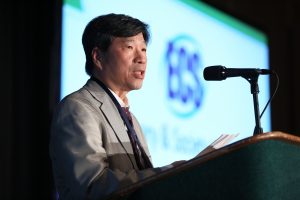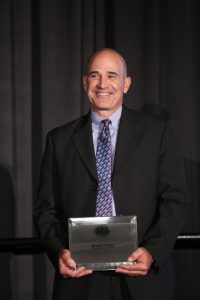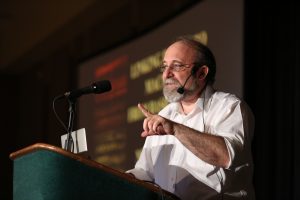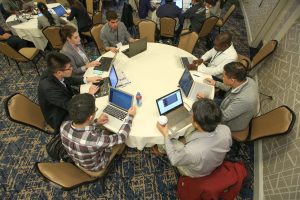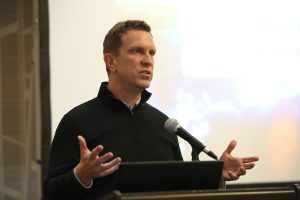Over 2,600 people from 53 countries attended the 233rd ECS Meeting in Seattle, WA, May 13-17, 2018—the largest spring meeting in the Society’s history! Participants could choose from 46 symposia, with over 2,000 oral talks and nearly 600 posters, of which almost 700 were student presentations.
Click here to see all of the photos from the 233rd ECS Meeting.
Opening Reception
A new and improved opening reception kicked off the meeting. Held in a spacious atrium in the Washington State Convention Center, the well-attended Sunday evening social event featured light snacks and an open bar. Visit Seattle personnel were in attendance to provide attendees information on the city and things to do during their stay. The lively event offered attendees ample opportunity to network.
Plenary Session
ECS Senior Vice President Yue Kuo welcomed attendees to the meeting during Monday evening’s plenary session, an event that wrapped up the day’s technical sessions, honored award winners, and featured the meeting’s ECS Lecture.
“It’s your attendance at our meetings, being a member of ECS, advocating with your libraries to subscribe to ECS publications, and publishing your work with ECS that allows us to continue to Free the Science,” Kuo said. “You should be proud as we continue to build a rich tradition of open science while supporting the next generation of scientists, ECS meetings, and each other.”
During the plenary, Kuo announced the launch of ECSarXiv, the Society’s new preprint service, as well as the Amazon Catalyst at ECS program, a new opportunity for ECS members to receive financial support to pursue solutions in health and sustainability.
Before introducing the meeting’s ECS Lecture, Kuo took an opportunity to honor the legacy of ECS Executive Director and CEO Roque Calvo, who—after over 37 years of service to the Society—is stepping down from his position.
“Roque has served as a steward of the Society for over 37 years,” Kuo said, “guiding the Society through tremendous changes while remaining dedicated to its mission to advance electrochemical and solid state science and technology.”
Kuo then highlighted some of the most significant accomplishments of Calvo’s tenure.
“Roque took the Society from print to digital, created an international audience for our programs and meetings, expanded the ECS Honors & Awards program, and encouraged student participation by instituting student chapters and adding more travel grants and fellowships,” Kuo said.
Kuo concluded by announcing the establishment of a new Society travel grant fund for students and early-career scientists and researchers—the Roque Calvo Next Generation Scholarship Fund—and by granting Calvo honorary membership with ECS in recognition of his long-standing devotion to the Society.
The ECS Lecture
Miguel Nicolelis, MD, PhD, delivered the ECS Lecture, “Linking Brains to Machines: From Basic Science to Neurological Neurorehabilitation,” to a packed audience Monday evening. Nicolelis is the Distinguished Professor of Neuroscience at Duke University and is the founder of Duke’s Center for Neuroengineering. He is founder and scientific director of the Edmond and Lily Safra International Institute for Neuroscience in Natal, Brazil. Nicolelis is also founder of the Walk Again Project, an international consortium of scientists and engineers dedicated to the development of exoskeleton devices to assist severely paralyzed patients in regaining full bodily mobility.
After recounting his early career in John K. Chapin’s laboratory, Nicolelis began his fascinating talk with how the brain encodes sensory and motor skills in animals and human beings. Some 86 billion brain cells are involved, and an understanding of how signals are processed and propagated may have implications in the treatment of many neurological diseases. He showed action potential experiments from surgically implantable devices in the rhesus monkey brain cortex; these electrodes could be left in the brain for years for continued experiments. Such brain/machine interfaces (BMIs) form the basis for discovering a series of key physiological principles that govern the operation of mammalian brain circuits.
Even more intriguing with these BMIs was the demonstration by Nicolelis and coworkers that animals and human subjects can utilize their electrical brain activity to directly control neuroprosthetic devices. He showed videos of monkeys and rats triggering robotic limbs to perform a variety of tasks, although a paraplegic human subject kicking a soccer ball was perhaps the most vivid demonstration of all.
This reporter has covered many plenary talks at ECS meetings, and it is no exaggeration to say that this was one of the most compelling and inspirational talks that he had heard in years. This talk provided a fitting start to the technical sessions that followed during the week-long meeting.
ECS Data Sciences Hack Week
Building on the success of the first ECS Data Sciences Hack Day (October 2017), the Society offered an expanded program at its Seattle meeting. The first ECS Data Sciences Hack Week kicked off on Monday and consisted of all-day sessions Wednesday through Friday, as well as optional software training tutorials during the week. These activities culminated with project presentations and an optional clamming expedition—a traditional activity in the Puget Sound area—on Saturday.
Like Hack Day, Hack Week was organized by Daniel Schwartz, David Beck, and Matthew Murbach of the University of Washington. Daniel Schwartz is the Boeing-Sutter Professor of Chemical Engineering and director of the Clean Energy Institute at the University of Washington. He brings electrochemistry and modeling expertise to the team. David Beck is a senior data scientist with the eSciences Institute at the University of Washington who leads regular hackathons. He is also the associate director of the NSF Data Intensive Research Enabling CleanTech PhD training program. Matthew Murbach is a past president of the ECS University of Washington Student Chapter and an advanced data sciences PhD trainee. He has been leading student section software development sessions on the UW campus and has practical experience coaching electrochemical scientists and engineers in software development.
The goal of the event was to increase the awareness and impact of data science tools, open source software, and shared datasets in electrochemistry and solid state science and technology by bringing together people from different backgrounds to collaborate.
Annual Society Business Meeting and Luncheon
During the Annual Society Business Meeting and Luncheon held on Tuesday, ECS leadership reported on the Society’s 2017 successes with a focus on the organization’s future.
“Now more than ever,” said ECS Senior Vice President Yue Kuo, “you’ll want to support ECS by making a donation, renewing your membership, and publishing with us—ideally, open access. These simple contributions allow you to support the next generation of scientists, our meetings, and ECS’s initiative to Free the Science that aims to make science more open.”
Following the reports, Kuo introduced a speaker—a new addition to the annual event. The speaker was David Danielson, managing director of Breakthrough Energy Ventures, who presented a talk titled “Electrochemistry & the Electrification of Everything in the Era of Low Cost Renewable Energy.”
Trip to Microsoft SOFC Powered Data Center
On Thursday a limited number of meeting attendees took part in an excursion to Microsoft’s state-of-the-art data center powered by solid oxide fuel cells.
Participants took a tour of the facility and had the opportunity to ask Microsoft staff questions about the test center and the SOFC technology involved.
Tickets for this high-demand event sold out quickly.
Award Highlights
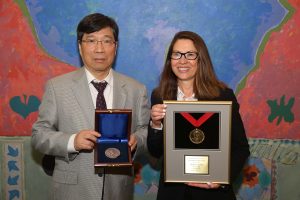
Hariklia (Lili) Deligianni (right) received the ECS Vittorio de Nora Award from ECS Senior Vice President Yue Kuo (left).
Two Society awards were presented during the plenary session.
The ECS Vittorio de Nora Award was presented to Hariklia (Lili) Deligianni. Deligianni is a research scientist in IBM’s Thomas J. Watson Research Center. Her current research interests include materials and devices for power electronics, bioelectronics, biosensors, and brain-inspired computing.
Deligianni has played a key role developing the solder bump technology that became the standard for the joining of silicon chips to packages. She coinvented copper electrodeposition for on-chip interconnects and was a corecipient of the 2006 Inventor of the Year Award from the New York Intellectual Property Law Association. For these technologies, IBM was recognized with the U.S. National Medal of Technology and Innovation. She has developed an electrodeposition route for the synthesis of solar thin film semiconductors and earth abundant solar materials and has been instrumental in the scale-up of thin film solar energy conversion technologies.
Deligianni holds PhD and MS degrees in chemical engineering from the University of Illinois at Urbana-Champaign and a BS in chemical engineering from Aristotelion University in Thessaloniki, Greece. She has coauthored 58 manuscripts and has 187 patents, with more than 30 patents pending with the United States Patent and Trademark Office. Deligianni is a member of the IBM Academy of Technology and an ECS fellow. In 2012, Deligianni was the first female recipient of the ECS Electrodeposition Division Research Award. She is a past secretary of ECS (2012-2016) and has served as chair of the ECS Education Committee, the ECS Ways and Means Committee, and the ECS Electrodeposition Division. She is a senior member of the Institute of Electrical and Electronics Engineers and the American Institute of Chemical Engineers and a member of the International Society of Electrochemistry, the American Chemical Society, the Association for Computing Machinery, and the American Association for the Advancement of Science.
The Vittorio de Nora Award was established in 1971 to recognize distinguished contributions to the field of electrochemical engineering and technology.
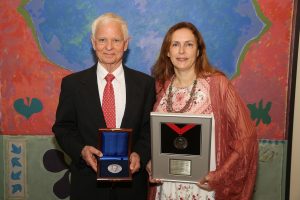
Ralph E. White (left), recipient of the ECS Henry B. Linford Award for Distinguished Teaching, with his wife, Marjorie Nicholson (right).
The ECS Henry B. Linford Award for Distinguished Teaching was presented to Ralph E. White. White is a professor of chemical engineering and a distinguished scientist at the University of South Carolina. He graduated from the University of South Carolina with a BS in chemical engineering in 1971. He then attended the University of California at Berkeley and completed his PhD in 1977 under the direction of John Newman.
White began his teaching career at Texas A&M University in 1977. In 1993 he moved to the University of South Carolina, where he served as the chair of the Department of Chemical Engineering for seven years and then as the dean of the College of Engineering and Computing for five years. In 1995 he founded the Center for Electrochemical Engineering.
White has published 338 peer-reviewed journal articles and has graduated 50 PhD and 39 MS students. He is a past treasurer of ECS (1990-1994) and a fellow of ECS, the American Institute of Chemical Engineers, and the American Association for the Advancement of Science. White has received several international awards, including the American Electroplaters and Surface Finishers Society Scientific Achievement Award (2000) for mathematical modeling of the electrodeposition of alloys, the ECS Olin Palladium Award (2013) for contributions to the science of electrochemistry, and the ECS Vittorio de Nora Award (2016) for contributions to the field of electrochemical engineering and technology. He has served as a consultant to several major companies, including Energizer and General Electric.
The Henry B. Linford Award for Distinguished Teaching was established in 1981 to recognize excellence in teaching in subject areas of interest to the Society.
Eight division awards were presented over the course of the meeting.
- The ECS Electronics and Photonics Division Award was presented to Tae-Yeon Seong of Korea University.
- The ECS Energy Technology Division Research Award was presented to Yushan Yan of the University of Delaware.
- The ECS Energy Technology Division Supramaniam Srinivasan Young Investigator Award was presented to Marίa Escudero Escribano of the University of Copenhagen.
- The ECS Energy Technology Division Graduate Student Award sponsored by Bio-Logic was presented to Deijun Xiong of Shenzhen Capchem Technology Co., Ltd.
- The ECS Industrial Electrochemistry and Electrochemical Engineering Division H. H. Dow Memorial Student Achievement Award was presented to Soo Kim of the Massachusetts Institute of Technology.
- The ECS Industrial Electrochemistry and Electrochemical Engineering Division Student Achievement Award was presented to Yasser Ashraf Gandomi of the University of Tennessee, Knoxville.
- The ECS Nanocarbons Division SES Young Investigator Award was presented to Michael S. Arnold of the University of Wisconsin-Madison.
- The ECS Organic and Biological Electrochemistry Division Manuel M. Baizer Award was presented to Flavio Maran of the University of Padova.
General Student Poster Session
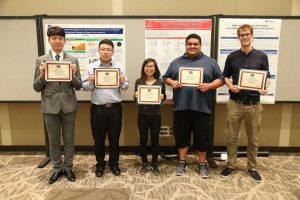
Winners of the General Student Poster Session (left to right): Jae Young Yoo, Hao Wang, Tammy Pham, Mario Cedano, and David Reber.
There were 103 posters presented in the General Student Poster Session. The session’s award winners are listed below.
- Mario Cedano, San Diego State University, “Redox-Responsive Dimerization in a Ferrocene-Ureidopyrimidinone Supramolecular Assembly”
- Hao Wang, Beijing University of Chemical Technology, “Metal-Organic Framework Supported on Food Waste-Derived Carbon as an Efficient Bifunctional Catalyst for Oxygen Electrocatalysis”
- David Reber, École Polytechnique Fédérale de Lausanne, “High-Voltage Aqueous Electrolytes for Sodium-Ion Supercapacitors and Batteries”
- Jae Young Yoo, Korea Advanced Institute of Science and Technology, “Comprehensive Analysis of a Tubular, Reversible Solid Oxide Fuel Cell by Using a 3-D Computational Fluid Dynamics Model”
- Tammy Pham, San Diego State University, “Evaluating the Roles of Proton Transfer and H-Bonding in the Electron Transfer Reactions of Organic Redox Couples in Non-Aqueous Solvents: Oxidation of Phenylenediamines in the Presence of Pyridine Bases in Acetonitrile”
The following ECS division members served as student poster judges.
- Battery, Industrial Electrochemistry and Electrochemical Engineering, and Sensor Divisions: Tissaphern Mirfakhrai, Joshua Gallaway, and Roseanne Warren
- Dielectric Science and Technology and Electronics and Photonics Divisions: Nikolay Dimitrov, Douglas Riemer, Jan Froitzheim, and Paul Gannon
- Energy Technology Division: Andrea Bourke, Douglas Kushner, and Miomir Vukmirovic
- Corrosion, Electrodeposition, and Physical and Analytical Electrochemistry Divisions: Iwona Rutkowska, Eiji Tada, and Sadagopan Krishnan
- High Temperature Materials, Luminescence and Display Materials, Nanocarbons, and Organic and Biological Electrochemistry Divisions: Wilson Chiu, Mark Allendorf, Jeffrey Halpern, and Graham Cheek
ECS thanks the sponsors of the 233rd ECS Meeting, the faculty advisors, and the division members who served as judges for their support of the session.
Sponsors and Exhibitors
Special thanks to the meeting’s sponsors and exhibitors, whose support and participation directly contributed to the success of the meeting.
Thank you for developing the tools and equipment driving scientific advancement and for sharing your innovations with the ECS community.





